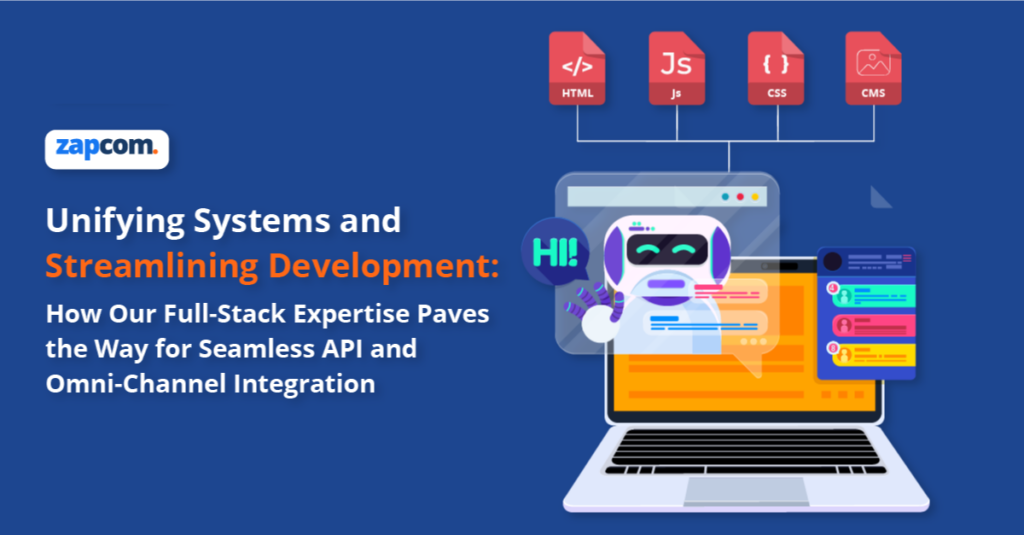Ready to bring your ideas to life?
Contact us for tailor-made solutions that cater to your business’s unique needs, goals, and challenges, helping you unlock its full potential.
As a full-stack developer, my goal is to build applications that are both robust and seamless. I want to create applications that are easy to use, intuitive, and performant. One of the most important tools in my arsenal is API integration. In this article, I will explore the power of seamless API integration and how it can be used to create truly masterful full-stack applications. Additionally, I will examine the role of omni-channel integration in full-stack development and provide some best practices for achieving successful integration.

Full stack development is a term that is often used in the software development industry to describe a developer who is capable of working on all layers of an application. This includes the front-end, back-end, and database layers. Full-stack developers are highly sought after because they are capable of building complete applications from start to finish.
API integration is a key component of full-stack development. An API, or application programming interface, is a set of protocols, routines, and tools for building software applications. APIs allow different software applications to communicate with each other, making it possible to share data and functionality across different applications.
Seamless API integration is important because it allows developers to create cohesive applications that work together seamlessly. When different applications can communicate with each other, it becomes possible to share data and functionality, which can save time and increase productivity.
There are many benefits to integrating APIs in full-stack development. One of the biggest benefits is the ability to share data and functionality across different applications. This can save time and increase productivity because developers don’t have to reinvent the wheel every time they build a new application.
Another benefit of API integration is that it allows developers to create more robust applications. By integrating APIs, developers can leverage the functionality of other applications, which can help them build more complex applications more quickly.
There are many different types of APIs, each with its own strengths and weaknesses. Some of the most common types of APIs include RESTful APIs, SOAP APIs, and GraphQL APIs.
RESTful APIs are the most commonly used type of API. They are simple to use and easy to understand, making them a great choice for many applications. SOAP APIs are more complex and powerful than RESTful APIs, but can be more difficult to use. GraphQL APIs are a newer type of API that allows clients to request only the data they need, which can improve performance.
Omni-channel integration is the process of integrating different channels of communication into a single seamless experience. This can include everything from websites and mobile apps to social media and email. The goal of omni-channel integration is to create a seamless experience for users, regardless of the channel they are using.
Omni-channel integration is important because it allows businesses to provide a consistent user experience across different channels. This can help to build brand loyalty and increase customer satisfaction. Additionally, omni-channel integration can help to increase sales by providing customers with a seamless shopping experience across different channels.
Omni-channel integration plays a critical role in full-stack development. By integrating different channels of communication, developers can create applications that provide a seamless experience for users. This can help to increase customer satisfaction and build brand loyalty.
Additionally, omni-channel integration can help developers to build more robust applications. By integrating different channels of communication, developers can leverage the functionality of other applications, which can help them to build more complex applications more quickly.
There are a few best practices that can help developers to achieve successful seamless API and omni-channel integration. One of the most important best practices is to use a consistent data format across all channels. This can help to ensure that data is consistent and accurate across different applications.
Another best practice is to use a common authentication mechanism across all channels. This can help to ensure that users are authenticated consistently across different applications, which can improve security and user experience.
Finally, it’s important to use a common error-handling mechanism across all channels. This can help to ensure that errors are handled consistently across different applications, which can improve user experience and reduce support costs.
There are many tools and technologies that can help developers to master full-stack development. Some of the most commonly used tools include IDEs like Visual Studio Code and Atom, version control systems like Git, and package managers like npm and Yarn.
Additionally, there are many frameworks and libraries that can help developers to build robust and performant applications. Some of the most popular frameworks include React, Angular, and Vue.js, while some of the most popular libraries include Redux, Express, and Axios.
There are many successful examples of seamless API and omni-channel integration in the real world. One notable example is Amazon, which has integrated its website, mobile app, and voice assistants to create a seamless shopping experience for users. Another example is Starbucks, which has integrated its mobile app, website, and in-store experience to create a seamless ordering and rewards experience for users.
In conclusion, seamless API and omni-channel integration are critical components of full-stack development. By integrating different applications and channels of communication, developers can create robust and performant applications that provide a seamless experience for users. To achieve successful integration, developers should follow best practices like using a consistent data format, a common authentication mechanism, and a common error handling mechanism. Additionally, developers should leverage the many tools and technologies available to them, including IDEs, version control systems, and frameworks and libraries.
Contact us for tailor-made solutions that cater to your business’s unique needs, goals, and challenges, helping you unlock its full potential.